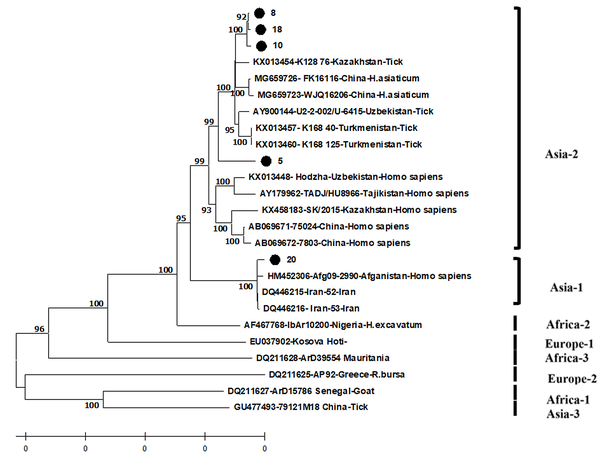1. Background
The Turkestan region of Kazakhstan is the endemic focus of the Congo-Crimean hemorrhagic fever (CCHF) (1). According to official statistics, 46 cases of CCHF were registered in the Turkestan region from 2016 to 2021 (2). Every year, some of the patients treated in hospitals are not included in the official statistics and remain in the group of possible cases of CCHF. The mortality rate in the region in some years varied between 14 - 30% (3). The heterogeneity of clinical manifestations and the different severity of the condition of patients with the corresponding severity of the outcomes of the CCHF are associated with the diversity of circulating genotypes of the virus in different countries (4-6). In Kazakhstan, only 1 study was conducted in the endemic (Kyzylorda) and non-endemic (Almaty) regions to identify the serological prevalence of the CCHF virus (CCHFV). A phylogenetic analysis of partial L and S segments showed the Asia-2 CCHF genotype and possible reassortment between Asia-1 and Asia-2 genotypes (7). Due to the lack of knowledge and the structure of the pathogen in the southern regions of Kazakhstan, an in-depth study of CCHFV is needed to analyze the phylogenetic tree of the RNA sequences of CCHFV in the Turkestan region and Shymkent City.
2. Objectives
This study aimed to verify the genotypes of CCHF in the Turkestan region and Shymkent City.
3. Methods
Twelve blood samples from patients with CCHF were studied, the diagnosis of which was verified on the basis of positive specific immunoglobulins IgM to the virus.
To isolate viral RNA, we used a special MAGNO-sorb kit, which was made by the Central Research Institute of Epidemiology, Moscow, Russian Federation, from 300-500 µL of blood samples. To detect RNA, CCHFV was carried out with a set of Amplisens CCHFV-FL by real-time polymerase chain reaction (PCR) using a Rotor-Gene Q device (Central Research Institute of Epidemiology, Russian Federation). For the reverse transcription reaction, we used a set of Reverta-L (Central Research Institute of Epidemiology, Moscow, Russian Federation) according to the manufacturer’s instructions. Amplicons for sequencing were obtained with the primers listed in Table 1. The S and M segments of virus RNA were sequenced using an ABI PRISM 3100 Genetic Analyzer (Applied Biosystems, USA) using a kit of reagents BigDye V3.1. A phylogenetic analysis of RNA sequences was performed using MEGA X software.
| Name of the Primer | 5” – 3” Sequence | Segment |
|---|---|---|
| CCHFV-S-F23 | TACGCCCACAGTGTTCTCTTGAGT | S |
| CCHFV-S-R756 | CCTGTTGCAACAAGTGCTATTCCT | |
| CCHFV-S-F645 | CGAGGCCCAGTGAGCCGTGAACA | |
| CCHFV-S-R1234 | TCCAAAGCAGACACCCATCTCACT | |
| CCHFV-S-F1094 | GCACTCTTGAGCACCCCAATGAA | |
| CCHFV-S-R1660 | CGCACAGCCCTTTAAGTGTTT | |
| CCHFV-M-F1256 | ATGTCACTCGACATTCAACTAGAATAG | M |
| CCHFV-M-R1927 | TAGGCAATAACCCTGCCTGCA | |
| CCHFV-M-F1862 | AGTGCCACAGGGAAGAGCTGTGA | |
| CCHFV-M-R2446 | AGGGCAATGAGTTACATGCCTAGCA | |
| CCHFV-M-F2368 | CTGCAGTTACAACATATGTCCCTA | |
| CCHFV-M-R3099 | TCCATCTCTACTGCTGAAGTGCT | |
| CCHFV-M-F2920 | TCATCAAYTGCACTTGAGCATCTGC | |
| CCHFV-M-R3613 | TGGGCAGTCACCTGTACAGGTT | |
| CCHFV-M-F3564 | TGTCTTCGAGTACTTGTCAGGTGA | |
| CCHFV-M-R4332 | TGTGGTGTGTCTCCATGTGCAG |
Primers Used Complementary DNA for Congo-Crimean Hemorrhagic Fever Virus Sequencing
4. Results
Of the 12 blood serum samples, CCHFV RNA was found in 10 blood serum samples (Figure 1). The concentration range of viral RNA was 30 to 107 copies/mL. For samples with a viral RNA concentration above 104 copies/mL, parts of the S and M segments of CCHFV with lengths of 1530 and 2920 nucleotides, respectively, were genotyped. The study of the genome sequence of CСHFV from GenBank demonstrated that isolates from the Turkestan region belonged to genetic groups Asia-1 (sample 20) and Asia-2 (samples 5, 8, 10, 18; Figures 2 and 3).
A phylogenetic analysis of fragments of the S segment of the Congo-Crimean hemorrhagic fever virus with a length of 1530 base pairs for the samples studied in this work, as well as for sequences from GenBank and the National Center for Biotechnology Information. The analysis was performed using neighbor-joining methods and the Tamura 3-parameter + G model, with bootstrap support of 500
A phylogenetic analysis of fragments of the M segment of the Congo-Crimean hemorrhagic fever virus with a length of 2920 base pairs for the samples studied in this work, as well as for fragments with a length of 2920 base pairs for sequences from GenBank and the National Center for Biotechnology Information. The analysis was performed using neighbor-joining methods and the Tamura 3-parameter+G model, with bootstrap support of 500
5. Discussion
Thus, in the Turkestan region of Kazakhstan, CCHFVs are circulating, corresponding to those in the endemic (Kyzylorda) and non-endemic (Almaty) regions of Kazakhstan, where the Asia-2 CCHF genotype and the reassortant between the Asia-1 and Asia-2 genotypes have been identified (7). In addition, the Asia-2 genotype shows its dominant position in the Turkestan region, as well as in China, Tajikistan, Uzbekistan, and Turkmenistan (8). As isolates belong to the Asia-1 genotype and taking into account the southernmost location of the region in the country, it can be assumed that there is a possible migration of this genotype of the virus from the countries of the Middle East, in particular Iran, where the Asia-1 genotype belonging to line IV is mainly registered (9), as well as Pakistan, Oman, Afghanistan, where the genotype of the Asia-1 virus also prevails (10).
5.1. Conclusions
For the first time in Kazakhstan’s history, a phylogenetic analysis of RNA sequences of viruses from patients with CCHF was performed in the Turkestan region, as a result of which genetic groups Asia-1, reassortant Asia-1, and Asia-2 were established.



